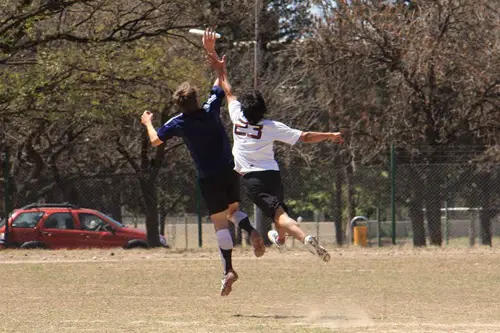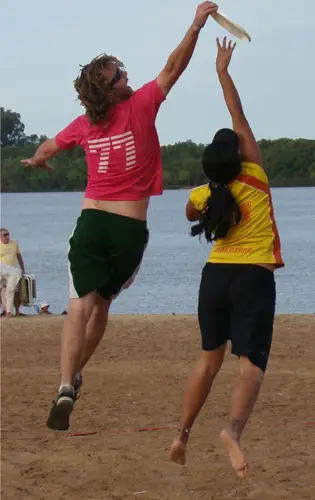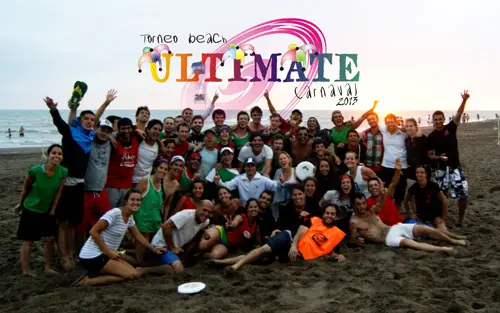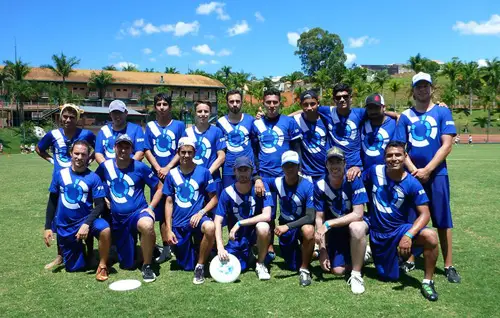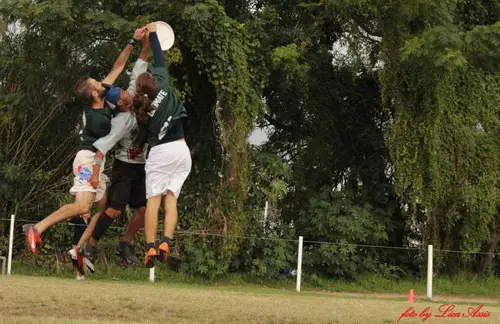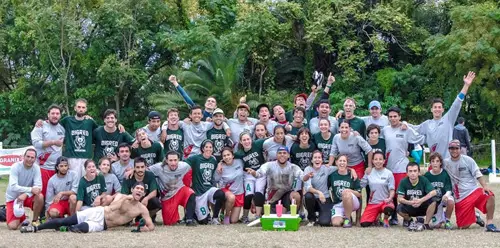Diana Antenucci is a 23-year-old Argentinian who has recently got her Bachelor Degree in Communications. She is a volunteer in the Argentinian Frisbee Association (Asociación de Deportes del Disco Volador de la República Argentina). In this interview she talks the situatuation of Ultimate Frisbee in Argentiana and other South American countries. You can visit their official website or like their Facebook Fan Page.

First four teams in downtown Buenos Aires. From left to right: Cadillacs, Aqua, Big Red and Discosur. (Southern Hemisphere’s) Spring 2009
When and why have you started playing Ultimate Frisbee?
I started playing 5 years ago, during my first year at college, and got to know the sport thanks to a professor coming from the States that already played and would always carry a disc and talk about ultimate (the sport is super unknown in Argentina, and I heard of it only a few months after the first and only team in the country had spread into two and a third and fourth teams were formed).
Why I started? I was looking for some sport that combined running and team play. I had played handball for several years but quitted because I felt that the team I had devoted so much time to was no longer a team, and playing had stopped being fun. And then I knew of ultimate, and more importantly, of ultimate players. The sport looked good (though the first time I watched it I understood very little), and the people were the best. So, basically, I started playing because of the people (the same reason why I had quitted handball before). But it wouldn’t have been an option if it hadn’t been a team sport that involved running and jumping. Then I understood the idea behind the Spirit of the Game, and all those things summed up are why I kept playing.
How many Frisbee clubs are there in Argentina?
Right now there are four consolidated mixed teams in downtown Buenos Aires, and about ten other small and growing communities in Argentina, most of them in the rest of Buenos Aires.
How many members are there overall?
There are around 200/250 players in the whole country.
What are the membership costs?
Joining any team/community is totally free, but for playing any tournament or competition you have to pay an individual fee. You can get a little discount in all events sponsored by the National Association by being a member, which costs about 15 dollars per year.
Has Argentina participated in any international tournaments?
Argentina participated with open teams in EAFIT (Colombia, 2007), TEP (“Torneo Eterna Primavera”, Colombia, 2009) and PAUCC (“Pan American Ultimate Club Championship”, Colombia, 2011 and Brazil, 2013).
The results weren’t remarkable but it was nothing unexpected: we play mixed in Argentina and the teams were brought together little before the tournaments, so most of the players had never played together before. All those who had the chance to participate did it with the clear idea of playing against and learning from great players from other countries.
Do you organize any tournaments within Argentina?
We have three established mixed tournaments throughout the year:
– beach hat tournament in Monte Hermoso, Buenos Aires, at the end of February / beginning of March.
– “Espíritu Sudaka” – international tournament during Holy Week in downtown Buenos Aires. This year’s edition had five teams from Argentina, two from Uruguay, two from Chile and one from Brazil.
– “Raza” – in Bahía Blanca, Buenos Aires, at the beginning of October.
There are smaller tournaments that change from year to year, and two leagues in downtown Buenos Aires (Autumn and Spring).
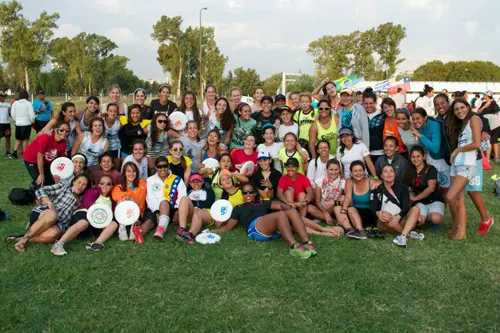
All the girls participating at “Espíritu Sudaka”, representing Argentina, Chile, Uruguay, Brazil and Venezuela. Holy Week 2013
What is your opinion about the “Ultimate Frisbee movement” in South America?
The “Ultimate Frisbee movement” in South America has three different levels.
First we have Colombia and Venezuela with hundreds of players, several teams, Open, Women, Mixed, Masters and Juniors divisions… They both participate in Worlds with very good results. In Colombia, the sport has spread through universities, secondary schools and government programs on social inclusion. (I’m not so familiarized with the history of Venezuela’s ultimate).
Then we have Argentina, Brazil, Chile and Uruguay with few teams, trying to grow communities in number of players and playing level. They all have a couple of tournaments of their own and regular leagues. These four countries are building strong bonds and growing together.
Finally, there are very little communities in Bolivia, Perú and Ecuador, trying to grow in number.
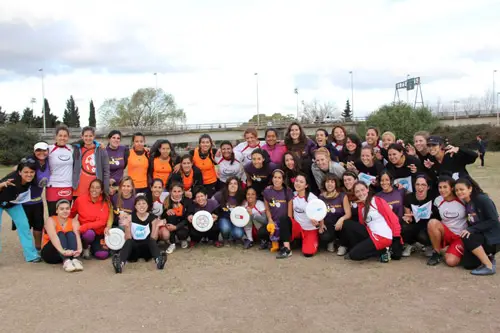
First Women’s tournament in Argentina, with three local teams and a visiting one from Brazil. Downtown Buenos Aires, mid 2013
What is the biggest difference between Ultimate Frisbee in Argentina and ultimate Frisbee in other South American countries?
Apart from differences in amount of players and playing level, in Colombia and Venezuela the strongest divisions are Open and Women, and they have Masters and Junior divisions, while in Argentina, Chile and Uruguay is Mixed (Brazil plays half the year Mixed and half Open/Women) and all ages play together.
Communities in Argentina and Chile have a strong foreign presence who help them grow (especially from Colombia, Venezuela and the United States). Uruguay and Brazil have mostly local players, and Colombia and Venezuela don’t depend on foreigners at all.

Downtown Buenos Aires team “Sapukay” playing against local team “Viento en Contra” in “Raza”. Bahía Blanca, south Buenos Aires. October 2013
Is it physically challenging?
Definitely. It depends on whether you want to play competitively or just recreationally, but either way you’ll still have to be able to run and jump a bit. Right now in Argentina we have all types of playing, though probably our club level is not as high as in other countries where the sport is way more popular.
Who is Ultimate Frisbee for? Why should anyone start playing Ultimate Frisbee?
Ultimate Frisbee is for everyone. I’ve met people playing from 10 to 60 years old, both men and women. People coming from other sports and people who had never practiced a sport in their life. People that joined for the physicality and people that got caught by the Spirit of the Game, the values, the inclusiveness and the sense of community. People who were looking for something different in their lives and people who just find in Ultimate another sportive option. Any of these is a good reason to start playing.
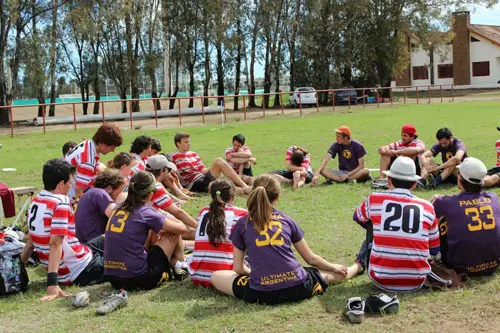
Spirit circle between downtown Buenos Aires team “Sapukay” and local team “Viento en Contra” in “Raza”. Bahía Blanca, south Buenos AiresOctober 2013
Do you have any personal “ultimate Frisbee experiences” you would like to share?
Too many! Not one in particular, but apart from being part of a team, sharing with people from different ages, backgrounds and countries, there’s a lot to do to grow the sport in the country. That means organising (tournaments, clinics, teams), teaching to people from all ages, talking with the media, building bridges between the different communities and so many more things. That is, assuming different roles and responsibilities, working with a team on and off the field, being open-minded to teach and learn from everyone… Too many enriching experiences to be lived and shared!
Thank you for your time.
Enjoy more photos documenting the history of Ultimate Frisbee in Argentina:
Argentina’s Open team “Stinga” at PAUCC 2013 in Brazil
Everyone at Beach Hat tournament in Monte Hermoso, Buenos Aires. February 2014
During Finals between downtown Buenos Aires teams “Big Red” and “V” in “Espíritu Sudaka”. Holy Week 2014
Finalists downtown Buenos Aires teams “Big Red” and “V” in “Espíritu Sudaka”. Holy Week 2014.
